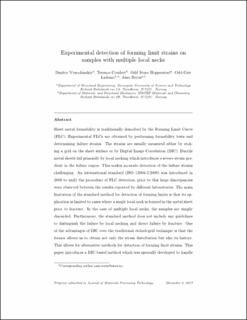| dc.contributor.author | Vysochinskiy, Dmitry | |
| dc.contributor.author | Coudert, Térence | |
| dc.contributor.author | Hopperstad, Odd Sture | |
| dc.contributor.author | Lademo, Odd-Geir | |
| dc.contributor.author | Reyes, Aase Gavina Roberg | |
| dc.date.accessioned | 2020-10-09T09:19:31Z | |
| dc.date.available | 2020-10-09T09:19:31Z | |
| dc.date.created | 2015-08-31T14:04:39Z | |
| dc.date.issued | 2016 | |
| dc.identifier.citation | Journal of Materials Processing Technology. 2016, 227 216-226. | en_US |
| dc.identifier.issn | 0924-0136 | |
| dc.identifier.uri | https://hdl.handle.net/11250/2681937 | |
| dc.description.abstract | Sheet metal formability is traditionally described by the forming limit curve (FLC). Experimental FLCs are obtained by performing formability tests and determining failure strains. The strains are usually measured either by etching a grid on the sheet surface or by digital image correlation (DIC). Ductile metal sheets fail primarily by local necking which introduces a severe strain gradient in the failure region. This makes accurate detection of the failure strains challenging. An international standard (ISO12004-2:2008) was introduced in 2008 to unify the procedure of FLC detection; prior to this large discrepancies were observed between the results reported by different laboratories. The main limitation of the standard method for detection of forming limits is that its application is limited to cases where a single local neck is formed in the metal sheet prior to fracture. In the case of multiple local necks, the samples are simply discarded. Furthermore, the standard method does not include any guidelines to distinguish the failure by local necking and direct failure by fracture. One of the advantages of DIC over the traditional etched-grid technique is that the former allows us to obtain not only the strain distribution but also its history. This allows for alternative methods for detection of forming limit strains. This paper introduces a DIC-based method which was specially developed to handle the case of multiple local necks and to distinguish failure by local necking from direct fracture automatically. The method is not confined to a single test type and can be used in combination with different formability tests as long as DIC is used to measure strains. | en_US |
| dc.language.iso | eng | en_US |
| dc.rights | Attribution-NonCommercial-NoDerivatives 4.0 Internasjonal | * |
| dc.rights.uri | http://creativecommons.org/licenses/by-nc-nd/4.0/deed.no | * |
| dc.title | Experimental detection of forming limit strains on samples with multiple local necks | en_US |
| dc.type | Peer reviewed | en_US |
| dc.type | Journal article | en_US |
| dc.description.version | acceptedVersion | en_US |
| dc.source.pagenumber | 216-226 | en_US |
| dc.source.volume | 227 | en_US |
| dc.source.journal | Journal of Materials Processing Technology | en_US |
| dc.identifier.doi | 10.1016/j.jmatprotec.2015.08.019 | |
| dc.identifier.cristin | 1260922 | |
| dc.relation.project | Norges forskningsråd: 237885 | en_US |
| dc.relation.project | Norges teknisk-naturvitenskapelige universitet: 174834 | en_US |
| cristin.unitcode | 7401,80,6,6 | |
| cristin.unitcode | 7401,80,0,0 | |
| cristin.unitname | Material- og konstruksjonsmekanikk | |
| cristin.unitname | SINTEF Materialer og kjemi | |
| cristin.ispublished | true | |
| cristin.fulltext | original | |
| cristin.fulltext | postprint | |
| cristin.qualitycode | 2 | |

